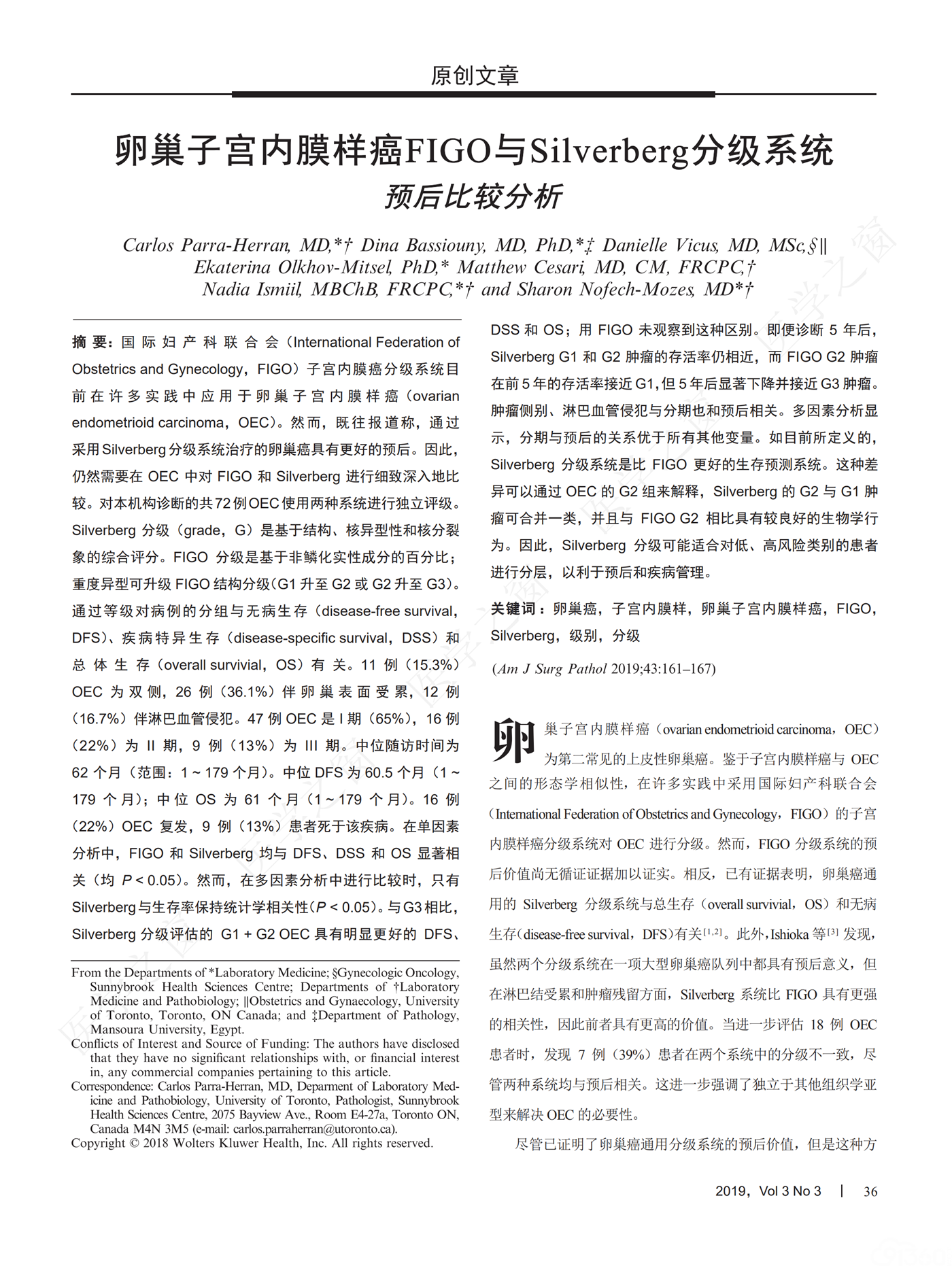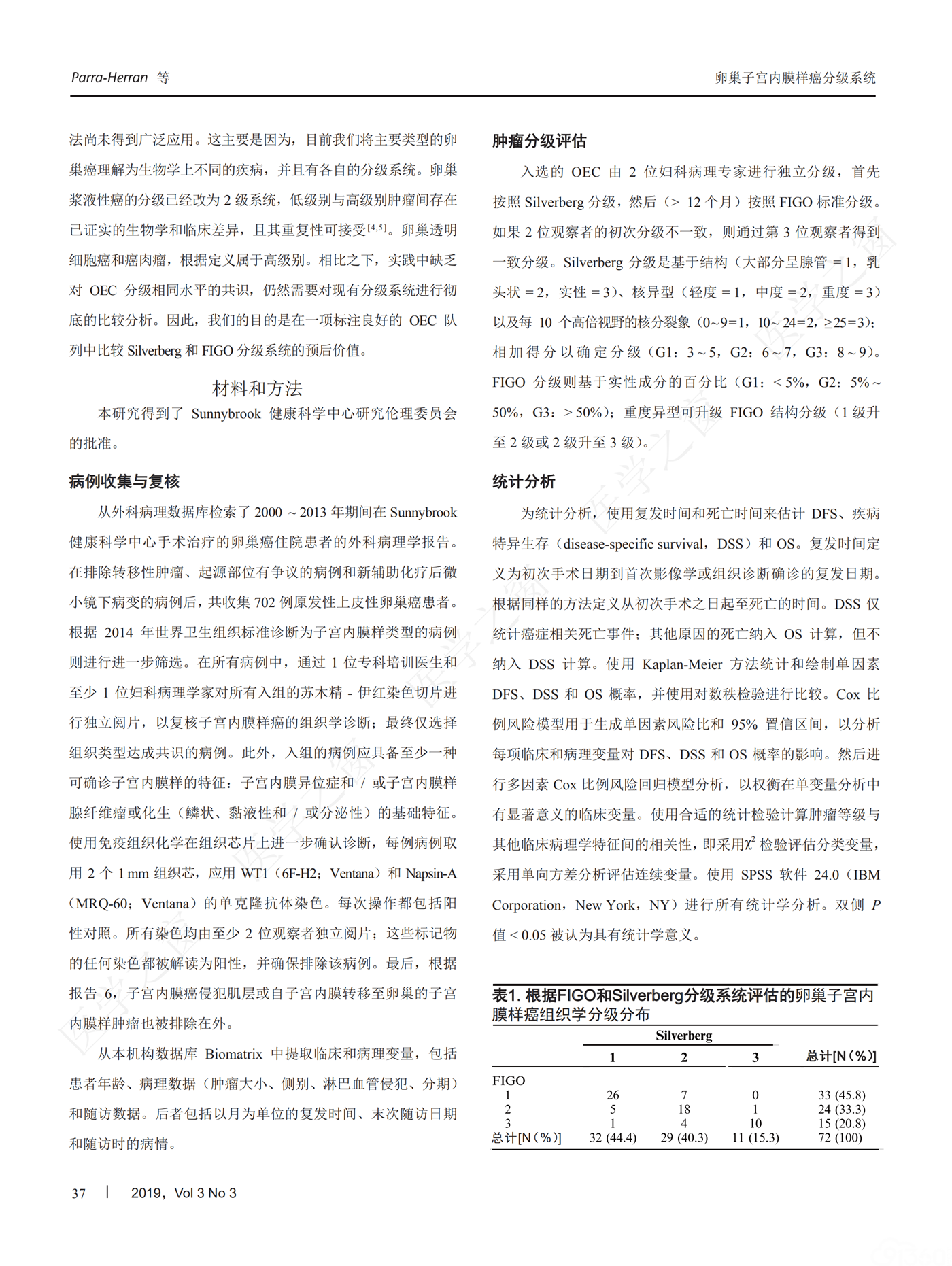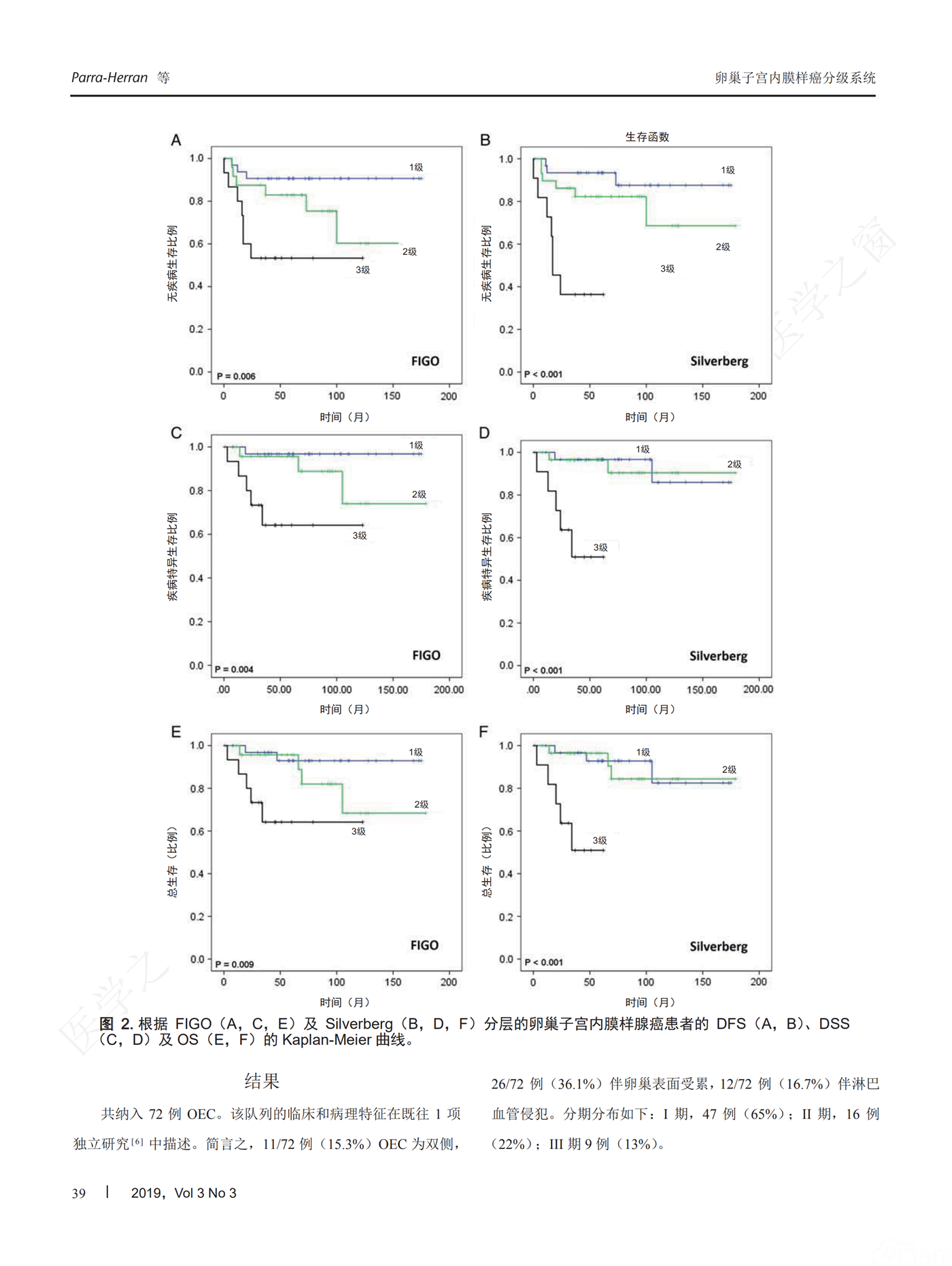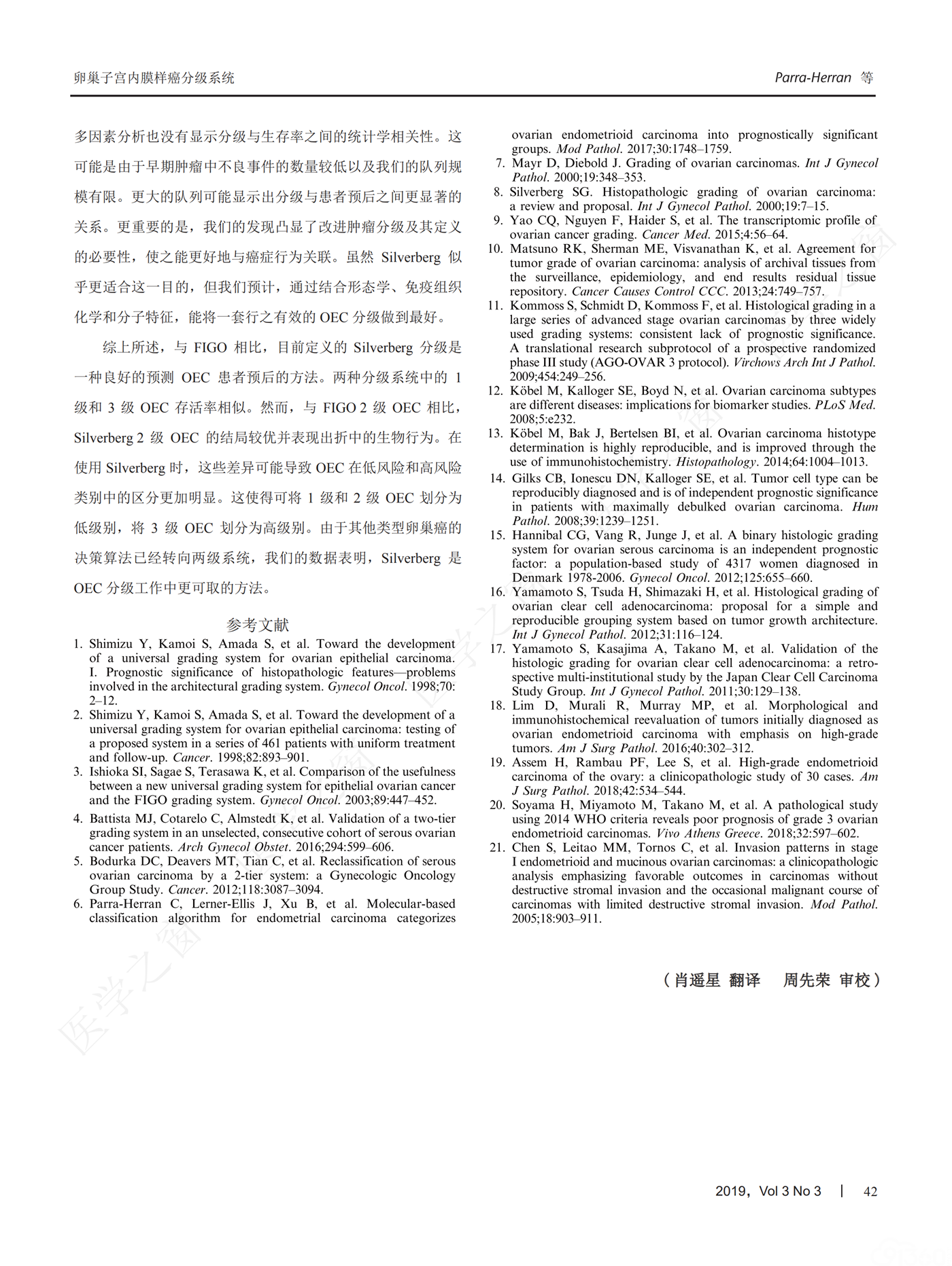摘要:国际妇产科联合会(International Federation of Obstetrics and Gynecology,FIGO)子宫内膜癌分级系统目前在许多实践中应用于卵巢子宫内膜样癌(ovarian endometrioid carcinoma,OEC)。然而,既往报道称,通过采用Silverberg分级系统治疗的卵巢癌具有更好的预后。因此,仍然需要在OEC中对FIGO和Silverberg进行细致深入地比较。对本机构诊断的共72例OEC使用两种系统进行独立评级。Silverberg分级(grade,G)是基于结构、核异型性和核分裂象的综合评分。FIGO分级是基于非鳞化实性成分的百分比;重度异型可升级FIGO结构分级(G1升至G2或G2升至G3)。通过等级对病例的分组与无病生存(disease-free survival,DFS)、疾病特异生存(disease-specific survival,DSS)和总体生存(overall survivial,OS)有关。11例(15.3%)OEC为双侧,26例(36.1%)伴卵巢表面受累,12例(16.7%)伴淋巴血管侵犯。47例OEC是I期(65%),16例(22%)为II期,9例(13%)为III期。中位随访时间为62个月(范围:1~179个月)。中位DFS为60.5个月(1~179个月);中位OS为61个月(1~179个月)。16例(22%)OEC复发,9例(13%)患者死于该疾病。在单因素分析中,FIGO和Silverberg均与DFS、DSS和OS显著相关(均P<0.05)。然而,在多因素分析中进行比较时,只有Silverberg与生存率保持统计学相关性(P<0.05)。与G3相比,Silverberg分级评估的G1+G2 OEC具有明显更好的DFS、DSS和OS;用FIGO未观察到这种区别。即便诊断5年后,SilverbergG1和G2肿瘤的存活率仍相近,而FIGO G2肿瘤在前5年的存活率接近G1,但5年后显著下降并接近G3肿瘤。肿瘤侧别、淋巴血管侵犯与分期也和预后相关。多因素分析显示,分期与预后的关系优于所有其他变量。如目前所定义的,Silverberg分级系统是比FIGO更好的生存预测系统。这种差异可以通过OEC的G2组来解释,Silverberg的G2与G1肿瘤可合并一类,并且与FIGO G2相比具有较良好的生物学行为。因此,Silverberg分级可能适合对低、高风险类别的患者进行分层,以利于预后和疾病管理。
关键词:卵巢癌,子宫内膜样,卵巢子宫内膜样癌,FIGO,Silverberg,级别,分级
(Am J Surg Pathol 2019;43:161-167)
美国外科病理学杂志中文版2019年第三期摘要NO.13
( 肖遥星 翻译 周先荣 审校 )







The American Journal of Surgical Pathology中文版声明:
©2018 Wolters Kluwer Health
The material is published by Wolters Kluwer Health with the permission of American Journal of Surgical Pathology.No part of this publication may be reproduced in any form,stored in a retrieval system or transmitted in any form,by any means,without prior written permission from Wolters Kluwer Health.Opinions expressed by the authors and advertisers are not necessarily those of the American Journal of Surgical Pathology, its affiliates,or of the Publisher.The American Journal of Surgical Pathology,its affiliates,and the Publisher disclaim any liability to any party for the accuracy,completeness,efficacy,or availability of the material contained in this publication (including drug dosages) or for any damages arising out of the use or non-use of any of the material contained in this publication.
Although advertising material is expected to conform to ethical (medical) standards,inclusion in this publication does not constitute a guarantee or endorsement of the quality or value of such product or of the claims made of it by its manufacturer.
【本文经《美国外科病理学杂志》授权发布,其他媒体转载或引用须经《美国外科病理学杂志》同意 ,否则追究法律责任;所有文章仅供公益交流,不代表本站立场。欢迎提供素材、资料等,投稿邮箱: tougao@91360.com,一经采纳将给予稿费】
©2018 Wolters Kluwer Health
The material is published by Wolters Kluwer Health with the permission of American Journal of Surgical Pathology.No part of this publication may be reproduced in any form,stored in a retrieval system or transmitted in any form,by any means,without prior written permission from Wolters Kluwer Health.Opinions expressed by the authors and advertisers are not necessarily those of the American Journal of Surgical Pathology, its affiliates,or of the Publisher.The American Journal of Surgical Pathology,its affiliates,and the Publisher disclaim any liability to any party for the accuracy,completeness,efficacy,or availability of the material contained in this publication (including drug dosages) or for any damages arising out of the use or non-use of any of the material contained in this publication.
Although advertising material is expected to conform to ethical (medical) standards,inclusion in this publication does not constitute a guarantee or endorsement of the quality or value of such product or of the claims made of it by its manufacturer.
【本文经《美国外科病理学杂志》授权发布,其他媒体转载或引用须经《美国外科病理学杂志》同意 ,否则追究法律责任;所有文章仅供公益交流,不代表本站立场。欢迎提供素材、资料等,投稿邮箱: tougao@91360.com,一经采纳将给予稿费】




 苏公网安备 32011402011742
苏公网安备 32011402011742